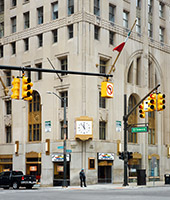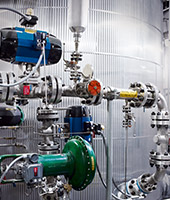Trends: Equity and Liabilities
Equity Up by 44 Percent
Group equity rose by € 848.6 million year over year, amounting to € 2.79 billion as of December 31, 2015 (Dec. 31, 2014: € 1.95 billion). The resulting equity ratio was 38.5 percent (Dec. 31, 2014: 28.0 percent). The Group’s net income for the year increased retained earnings by € 246.7 million, whereas the dividend payment of € 74.5 million reduced retained earnings. Other equity items increased equity, essentially as a result of the adjustment to pension provisions that was not recognized in the income statement. The remeasurement of defined benefit plans at the end of the financial year resulted in lower actuarial losses, which increased equity by € 131.9 million. Currency translation effects increased equity by € 141.9 million.
When Siltronic AG went public on June 11, 2015, 12.65 million shares were placed with investors, of which 5.0 million were new shares issued through a capital increase at Siltronic and 7.65 million were shares originally held by WACKER. As a result of the IPO, WACKER increased its equity by € 361.9 million. At the same time, WACKER’s stake in Siltronic AG was reduced from 100 percent to 57.8 percent. The free float for Siltronic AG now stands at 42.2 percent. Since the Group still retains the majority of shares in the company, the equity of Wacker Chemie AG shareholders climbed by € 197.1 million as a result of the transaction. At the same time, the share of non-controlling interests in Group equity rose by € 164.8 million. At the end of the financial year, the share of non-controlling interests in the Siltronic Group amounted to € 196.6 million.
Liabilities
Compared with the previous year, WACKER’s liabilities fell by € 531.4 million, or almost 11 percent, and amounted to € 4.47 billion (Dec. 31, 2014: € 5.0 billion). They accounted for 62 percent of total equity and liabilities (Dec. 31, 2014: 72 percent).
Noncurrent Liabilities
As of the balance sheet date, noncurrent liabilities amounted to € 3.31 billion (Dec. 31, 2014: € 3.84 billion), down 14 percent year over year. They accounted for 46 percent of total equity and liabilities (Dec. 31, 2014: 55 percent). Provisions for pensions fell by € 146.5 million to € 1.61 billion, a decrease of 8 percent. This decline was attributable to the newly determined discount rate for defined benefit plans, which was higher than at year-end 2014. As of the balance sheet date, the discount rate was 2.75 percent in Germany and 4.2 percent in the USA (Dec. 31, 2014: 2.3 percent in Germany and 3.8 percent in the USA). Provisions for pensions accounted for 22 percent of total equity and liabilities (Dec. 31, 2014: 25 percent). Other noncurrent provisions increased, amounting to € 217.0 million (Dec. 31, 2014: € 181.8 million). In this context, low interest rates had an impact on anniversary-payment provisions and provisions for environmental protection. Provisions for phased early retirement increased due to the corresponding new contracts concluded during the financial year.
Noncurrent financial liabilities fell by € 181.5 million to € 1.14 billion (Dec. 31, 2014: € 1.32 billion). Noncurrent financial liabilities totaling € 200 million were reclassified as current due to their maturities. Overall, other noncurrent liabilities were lower at € 293.5 million (Dec. 31, 2014: € 533.9 million). This was due to the change in noncurrent advance payments received. They amounted to € 287.5 million as of the balance sheet date (Dec. 31, 2014: € 523.0 million). The retention of advance payments received in connection with terminated contracts with polysilicon customers led to a substantial reduction in noncurrent advance payments.
Current Liabilities
Current liabilities remained constant year over year, totaling € 1.16 billion (Dec. 31, 2014: € 1.16 billion) and accounting for 16 percent of total equity and liabilities. At € 378.3 million, trade payables were roughly the same as in the previous year (Dec. 31, 2014: € 374.5 million). The high level of capital expenditures, especially for the production site in Charleston, Tennessee (USA), was the reason for the large amount of trade payables. Other current provisions and liabilities fell 9 percent to € 460.6 million (Dec. 31, 2014: € 507.1 million). Current advance payments received amounted to € 165.8 million as of the reporting date (Dec. 31, 2014: € 166.1 million). Current income tax provisions and liabilities for forward-exchange contracts were lower at the end of the financial year. The fair value of currency hedging instruments was firmly in negative territory due to the euro’s decline against the US dollar. Personnel liabilities, including those related to vacation, flextime and performance-related compensation, were higher as of the balance sheet date.
WACKER Posts Net Financial Debt of € 1.07 Billion
Current financial liabilities were 12 percent higher and amounted to € 318.7 million as of December 31, 2015 (Dec. 31, 2014: € 283.3 million). The primary reason for this increase was the reclassification of noncurrent items as current. In Q2 2015, the company repaid € 150.0 million on a promissory note (German Schuldschein). Overall, financial liabilities fell 9 percent to € 1.46 billion (Dec. 31, 2014: € 1.60 billion) and accounted for 20 percent of total equity and liabilities. The depreciation of the euro against the US dollar and other currencies caused financial liabilities to increase by € 60 million. Current liquidity (current securities, cash and cash equivalents) fell slightly, amounting to € 377.7 million (Dec. 31, 2014: € 483.3 million). Noncurrent securities decreased from € 37.6 million to € 3.7 million. As of December 31, 2015, WACKER had net financial debt (the balance of gross financial debt and noncurrent and current liquidity) totaling € 1,074.0 million (Dec. 31, 2014: € 1,080.6 million).
Unrecognized Assets and Off-Balance-Sheet Financing Instruments
An important asset that does not appear in our statement of financial position is the value of the WACKER brand and other Group trademarks. We consider the high profile and reputation of our trademarks to be a key factor influencing customer acceptance of our products and solutions. Moreover, there are other intangible assets that are vital for success and have a positive impact on our business – for example, long-standing customer relationships and customer trust in our product- and solution-related expertise. Just as important are our employees’ skills and experience, and our many years of expertise, not only in R & D and project management, but also in designing products, and production and business processes. In particular, our integrated production system gives us an edge over our rivals. Another key success factor is WACKER’s sales network, which has evolved over many years and enables the Group to market and sell its range of products and services locally to customers. Various German legal forms of rented and leased goods (operating leases) reported on in Note 17 are also not included in the statement of financial position, nor are other self-constructed assets. WACKER does not use any off-balance-sheet financing instruments.




